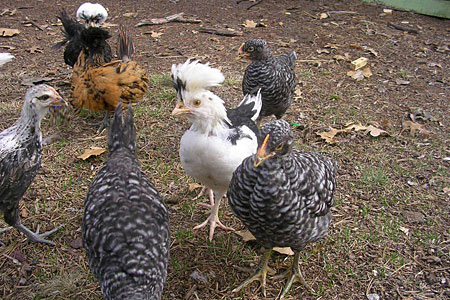
Like a lot of chicken keepers, you might want to include a variety of breeds in your backyard flock. Maybe you look forward to gathering baskets full of colorful eggs. Or, rather than all one breed of the same color and type, you prefer a more interesting variety of colors, sizes, and personalities. Or maybe you simply have trouble settling on just one breed. To successfully mix different chicken breeds in one flock you need to know something about the characteristics of each breed you choose.
Compatible Characteristics
The first thing to look for is breeds with similar temperaments. Many breeds are docile, others are more assertive. Some docile breeds tend to be easily bullied by the more assertive breeds.
Size matters to a certain extent, but not as much as temperament. A feisty small breed may be too much for a larger but more tranquil breed. On the other hand, chickens of vastly different sizes may get along just fine if all are relatively serene. The bigger issue would be to make sure all sizes are able to access the feeders and drinkers.
Climate adaptability is another feature to consider. Some breeds are more tolerant of warm weather, others do better in cold weather. A few are flexible all-climate breeds. Choosing breeds that easily adapt to similar weather conditions results in a more cohesive flock.
If your flock consists of only hens, you have a bit more latitude in breed selection. Hens are generally less aggressive than roosters, but not always. When mixing breeds of different temperaments in one flock, keep a watchful eye and be prepared to step in should conflicts occur.
Flock Size
The total number of chickens in your flock will also determine, to some extent, how readily the different breeds get alone. Chicken social structure dictates that it takes at least three chickens to make a flock. So, depending on the overall size of your flock, and the total number of chickens involved, you’d be wise to include at least three of each breed so they can lean on each other for comfort and support.
Why does that matter? Because chickens (like human kids) tend to pick on an individual that looks different from all the rest. Take, for example, a single crested chicken mixed with flock of non-crested breeds. Beards and feathered legs also draw attention. So does plumage color, if all the chickens in the flock are the same color except for one.
On the other hand, if you want a lot of variety in a small flock of, say, less than a dozen chickens, you might include just one of each breed. That way no particular chicken will stand out as being different from all the others.
Compatible Breeds
Cold hardy breeds that are docile and easily bullied get along well together. Examples are:
Docile all-climate breeds that fit this mix include:
Cold hardy breeds that are equally docile and would do well in the same mix include:
However, these breeds are not as easily bullied and therefore would more readily stand up to chickens that tend to be a little more assertive. In addition to mixing well with strictly docile breeds, they also would mix well with breeds that are generally docile but can get a little pushy. For example:
More difficult to identify are heat tolerate breeds that are docile enough for a mixed flock. In addition to the all-climate breeds, the few heat tolerant breeds that come to mind are:
Among crested chickens, docile heat tolerant breeds include:
All-climate crested breeds that are a bit more assertive are:
Keeping the Peace
Although you’ll see some degree of peck-order jostling in any flock of chickens, by selecting the right mix of breeds your chickens should get along well with minimal strife. Also helpful is a rich environment with plenty of space to let the more timid chickens find peaceful places away from the more active birds.
And that’s today’s news from the Cackle Coop.
Gail Damerow is the author of Storey’s Guide to Raising Chickens.

